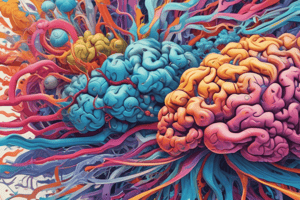Podcast
Questions and Answers
What is primarily developed during social internships in adolescence?
What is primarily developed during social internships in adolescence?
- Cognitive skills
- Social roles and responsibilities (correct)
- Physical fitness
- Emotional intelligence
Which factor is central to the adolescent's life according to the content?
Which factor is central to the adolescent's life according to the content?
- Peer relationships (correct)
- Community involvement
- Academic achievements
- Family dynamics
What can serve as a negative influence on adolescents, as mentioned in the content?
What can serve as a negative influence on adolescents, as mentioned in the content?
- Pro-social behaviors
- Family traditions
- Peer pressure (correct)
- Community support
At what age do preschoolers typically label themselves as a boy or a girl?
At what age do preschoolers typically label themselves as a boy or a girl?
Erikson's psychosocial theory contains how many stages across the lifespan?
Erikson's psychosocial theory contains how many stages across the lifespan?
What does each psychosocial crisis entail according to Erikson?
What does each psychosocial crisis entail according to Erikson?
What can happen if psychosocial crises are not dealt with effectively according to Erikson?
What can happen if psychosocial crises are not dealt with effectively according to Erikson?
What is reinforced through caregivers' differential treatment of children according to the content?
What is reinforced through caregivers' differential treatment of children according to the content?
Which behavior is classified as risk behavior in adolescents?
Which behavior is classified as risk behavior in adolescents?
What important developmental function does conflict serve during adolescence?
What important developmental function does conflict serve during adolescence?
What characterizes the formal operational period in adolescence?
What characterizes the formal operational period in adolescence?
Which concept illustrates the belief that adolescents are the center of attention in every situation?
Which concept illustrates the belief that adolescents are the center of attention in every situation?
What is one implication of adolescent egocentrism?
What is one implication of adolescent egocentrism?
How is cognitive development viewed in early adulthood compared to adolescence?
How is cognitive development viewed in early adulthood compared to adolescence?
What is a typical cognitive change observed during middle adulthood?
What is a typical cognitive change observed during middle adulthood?
Which cognitive behavior is commonly associated with personal myths in adolescents?
Which cognitive behavior is commonly associated with personal myths in adolescents?
What is a distinguishing feature of mature cognitive development compared to adolescent thought?
What is a distinguishing feature of mature cognitive development compared to adolescent thought?
What reflects the contemporary view of cognitive development beyond adolescence?
What reflects the contemporary view of cognitive development beyond adolescence?
Which traditional characteristic is often associated with mature cognitive development?
Which traditional characteristic is often associated with mature cognitive development?
What is a key biological factor associated with PTSD?
What is a key biological factor associated with PTSD?
Which psychological factor may increase vulnerability to PTSD in an individual?
Which psychological factor may increase vulnerability to PTSD in an individual?
What distinguishes complex PTSD from standard PTSD?
What distinguishes complex PTSD from standard PTSD?
Which is a common community factor that can contribute to PTSD among individuals?
Which is a common community factor that can contribute to PTSD among individuals?
Which neurobiological finding is typically observed in individuals with PTSD?
Which neurobiological finding is typically observed in individuals with PTSD?
What is meant by the term 'dissociative amnesia' in the context of PTSD?
What is meant by the term 'dissociative amnesia' in the context of PTSD?
What distinguishes acute stress disorder from post traumatic stress disorder?
What distinguishes acute stress disorder from post traumatic stress disorder?
Which of the following is NOT considered a normal response to trauma?
Which of the following is NOT considered a normal response to trauma?
Which event is an example of a traumatic experience that could lead to PTSD?
Which event is an example of a traumatic experience that could lead to PTSD?
What symptom characterizes hyperarousal in PTSD?
What symptom characterizes hyperarousal in PTSD?
What cognitive ability allows adolescents to think more abstractly, idealistically, and logically?
What cognitive ability allows adolescents to think more abstractly, idealistically, and logically?
Which of the following disorders involves a pattern of inhibited behavior toward a caregiver?
Which of the following disorders involves a pattern of inhibited behavior toward a caregiver?
What does fluid intelligence refer to concerning its trajectory during adulthood?
What does fluid intelligence refer to concerning its trajectory during adulthood?
In which situation would adjustment disorder typically occur?
In which situation would adjustment disorder typically occur?
What is a common symptom of intrusion in PTSD?
What is a common symptom of intrusion in PTSD?
Which of the following describes personal myths as perceived by adolescents?
Which of the following describes personal myths as perceived by adolescents?
According to Erik Erikson, what is the main psychosocial challenge faced during middle adulthood?
According to Erik Erikson, what is the main psychosocial challenge faced during middle adulthood?
How long must symptoms persist for PTSD to be diagnosed?
How long must symptoms persist for PTSD to be diagnosed?
Which of the following is true regarding disinhibited social engagement disorder?
Which of the following is true regarding disinhibited social engagement disorder?
Which stage of development, according to Erikson, involves the crisis of identity versus identity confusion?
Which stage of development, according to Erikson, involves the crisis of identity versus identity confusion?
What is the primary focus of psychological theory regarding risk-taking behaviors in adolescents?
What is the primary focus of psychological theory regarding risk-taking behaviors in adolescents?
Which statement about normal responses to trauma is accurate?
Which statement about normal responses to trauma is accurate?
What do personal myths often illustrate about adolescent perceptions of themselves?
What do personal myths often illustrate about adolescent perceptions of themselves?
During which stage of development does Erikson suggest that peer pressure becomes a key issue?
During which stage of development does Erikson suggest that peer pressure becomes a key issue?
What does the decline in body systems during late adulthood indicate?
What does the decline in body systems during late adulthood indicate?
What aspect of cognitive development is typically associated with adolescence according to Piaget?
What aspect of cognitive development is typically associated with adolescence according to Piaget?
Flashcards are hidden until you start studying
Study Notes
Adolescence Cognitive Development
- Formal operational period spans from 11 years to adulthood.
- Enables application of logic to abstract concepts like justice, love, and free will.
- Adolescent egocentrism leads to self-preoccupation and heightened self-consciousness.
- Personal myths refer to fantasies of being unique and special; the invincibility fable describes unrealistic beliefs of being untouchable, promoting risk-taking behavior.
- Imaginary audience reflects the belief that one is always the center of attention, intensifying self-consciousness.
- Mature cognitive development is characterized by rationality and self-sufficiency, often viewed as masculine traits.
Early Adulthood
- Some theorists suggest that cognitive development continues to evolve beyond formal operations.
- Thinking becomes more complex, adaptive, and less absolute, equipping individuals to manage life's unpredictable challenges effectively.
Middle Adulthood
- Cognitive changes vary widely; some individuals maintain cognitive abilities similar to those in early adulthood.
- Episodic memory can decline steadily, with a sharper decrease noted in early middle adulthood.
Social Internship During Adolescence
- Adolescents are inducted into social roles, preparing them for adulthood and fostering responsibility.
- The desire for autonomy can trigger conflicts with family and community, which is crucial for developing independence.
Peer Influence
- Peer relationships become central, with substantial time spent with peers.
- Conformity within peer groups can encourage pro-social behaviors, alongside potential negative influences like teenage pregnancy and substance abuse.
Risk-Taking Behavior
- Defined as actions that expose individuals to potential negative consequences socially, psychologically, or physically.
Gender Concept Development
- Binary sex assigned at birth influences gender identity formation by age three, leading to adoption of gender roles reinforced by caregiver treatment.
Erikson’s Psychosocial Theory
- Comprises 8 stages, each characterized by a psychosocial crisis that shapes personality.
- Successful resolution of these crises strengthens the individual, while failure may result in struggles with self-identity.
Psychopathology
- Defined as mental illness, with many normal responses to trauma including anxiety, distressing memories, and difficulty sleeping.
- Abnormal responses develop if symptoms persist beyond the typical recovery period after a traumatic event.
Trauma & Stressor Related Disorders
- Include Reactive Attachment Disorder and Post-Traumatic Stress Disorder (PTSD), the latter stemming from exposure to serious life-threatening events.
- PTSD symptoms encompass hyperarousal, intrusion (flashbacks, nightmares), and emotional constriction.
Biological and Psychological Factors in PTSD
- Genetic links suggest inherited vulnerability; neuroimaging shows differences in brain activity related to emotional regulation and memory.
- Psychological predispositions, including personality traits and prior mental health issues, influence trauma responses.
Social Factors Influencing PTSD
- High-crime and politically unstable regions contribute to trauma prevalence.
- Complex PTSD arises from prolonged abuse or repeat exposure to community violence, leading to cumulative trauma effects.
Discussion Points
- Communities facing continuous trauma may not experience a standard post-trauma phase typical of PTSD, leading to debates on necessary diagnostic categories for mental health conditions.
Studying That Suits You
Use AI to generate personalized quizzes and flashcards to suit your learning preferences.




